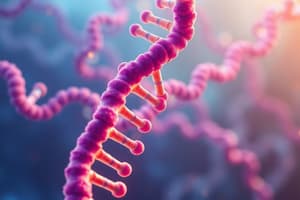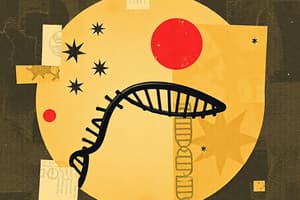Podcast
Questions and Answers
Which of these is a purine base?
Which of these is a purine base?
- Guanine (correct)
- Thymine
- Cytosine
- Uracil
What is the main difference between RNA and DNA?
What is the main difference between RNA and DNA?
- RNA contains uracil, while DNA contains thymine. (correct)
- RNA is always linear, while DNA can be circular.
- RNA contains thymine, while DNA contains uracil.
- RNA is double-stranded, while DNA is single-stranded.
In the DNA molecule, what type of bond holds the two strands together?
In the DNA molecule, what type of bond holds the two strands together?
- Covalent bonds
- Ionic bonds
- Van der Waals interactions
- Hydrogen bonds (correct)
Which scientist is credited with using X-ray crystallography to reveal the structure of DNA?
Which scientist is credited with using X-ray crystallography to reveal the structure of DNA?
What is the significance of Chargaff's Rules in understanding DNA structure?
What is the significance of Chargaff's Rules in understanding DNA structure?
What is the term for the alternative forms of nitrogenous bases?
What is the term for the alternative forms of nitrogenous bases?
What does the term 'antiparallel' refer to in the context of DNA structure?
What does the term 'antiparallel' refer to in the context of DNA structure?
Which of the following is NOT a level of DNA packaging in eukaryotic cells?
Which of the following is NOT a level of DNA packaging in eukaryotic cells?
What is the primary purpose of DNA within living organisms?
What is the primary purpose of DNA within living organisms?
Which of the following correctly describes the structure of DNA?
Which of the following correctly describes the structure of DNA?
Which nitrogenous bases are classified as purines in DNA?
Which nitrogenous bases are classified as purines in DNA?
What type of bond primarily connects nucleotides in a DNA polynucleotide chain?
What type of bond primarily connects nucleotides in a DNA polynucleotide chain?
How is the sequence of nitrogenous bases in DNA written by convention?
How is the sequence of nitrogenous bases in DNA written by convention?
Which components make up a nucleotide?
Which components make up a nucleotide?
What distinguishes RNA from DNA?
What distinguishes RNA from DNA?
How is prokaryotic DNA organized?
How is prokaryotic DNA organized?
What is the role of nucleosomes in eukaryotic DNA?
What is the role of nucleosomes in eukaryotic DNA?
What is a unique feature of eukaryotic DNA compared to prokaryotic DNA?
What is a unique feature of eukaryotic DNA compared to prokaryotic DNA?
What is the primary structure of a protein characterized by?
What is the primary structure of a protein characterized by?
What role does Chargaff's work play in understanding DNA?
What role does Chargaff's work play in understanding DNA?
Which type of bond primarily stabilizes tertiary structures in proteins?
Which type of bond primarily stabilizes tertiary structures in proteins?
How are polypeptides and proteins formed?
How are polypeptides and proteins formed?
Which principle is described by the quaternary structure of proteins?
Which principle is described by the quaternary structure of proteins?
What type of group is NOT a part of an amino acid's structure?
What type of group is NOT a part of an amino acid's structure?
Which level of protein structure is primarily involved with the arrangement of amino acid chains?
Which level of protein structure is primarily involved with the arrangement of amino acid chains?
DNA is primarily classified as which type of molecule?
DNA is primarily classified as which type of molecule?
Flashcards
Deoxyribonucleic acid (DNA)
Deoxyribonucleic acid (DNA)
The chemical compound responsible for storing and transmitting genetic information in most organisms.
Nucleotide
Nucleotide
The building blocks of DNA and RNA, composed of a sugar, a phosphate group, and a nitrogenous base.
Phosphoester bond
Phosphoester bond
A type of bond that connects the sugar and phosphate groups in a nucleotide.
Glycosidic bond
Glycosidic bond
Signup and view all the flashcards
Base sequence
Base sequence
Signup and view all the flashcards
Pyrimidines
Pyrimidines
Signup and view all the flashcards
Purines
Purines
Signup and view all the flashcards
Tautomeric Forms of Bases
Tautomeric Forms of Bases
Signup and view all the flashcards
Antiparallel DNA Strands
Antiparallel DNA Strands
Signup and view all the flashcards
Complementary Base Pairing
Complementary Base Pairing
Signup and view all the flashcards
Chargaff's Rules
Chargaff's Rules
Signup and view all the flashcards
Chromatin
Chromatin
Signup and view all the flashcards
Nucleosome
Nucleosome
Signup and view all the flashcards
Alpha Helix
Alpha Helix
Signup and view all the flashcards
Beta Sheet
Beta Sheet
Signup and view all the flashcards
Deoxyribose
Deoxyribose
Signup and view all the flashcards
Prokaryotic DNA
Prokaryotic DNA
Signup and view all the flashcards
What is the reason behind DNA's uniform size?
What is the reason behind DNA's uniform size?
Signup and view all the flashcards
Primary Protein Structure
Primary Protein Structure
Signup and view all the flashcards
Secondary Protein Structure
Secondary Protein Structure
Signup and view all the flashcards
Tertiary Protein Structure
Tertiary Protein Structure
Signup and view all the flashcards
Quaternary Protein Structure
Quaternary Protein Structure
Signup and view all the flashcards
Peptide bond
Peptide bond
Signup and view all the flashcards
What is DNA?
What is DNA?
Signup and view all the flashcards
What is RNA?
What is RNA?
Signup and view all the flashcards
Study Notes
DNA, RNA, and Proteins
- Friedrich Miescher isolated "nuclein" from pus cells in 1844-1895, a key step in discovering DNA.
- DNA and RNA are both nucleic acids with nucleotides as their subunits.
- Nucleotides consist of a nitrogenous base, a pentose sugar, and a phosphate group.
- DNA's sugar is deoxyribose, while RNA's is ribose.
- DNA bases: adenine (A), guanine (G), cytosine (C), thymine (T). RNA has uracil (U) instead of thymine.
- Nucleosides are the combination of a sugar and a nitrogenous base.
- DNA is a double helix, a twisted ladder. The strands run antiparallel (5' to 3' and 3' to 5').
- Complementary base pairing holds the DNA strands together (A with T, G with C).
- DNA's structure is stabilized by hydrogen bonds between bases.
- Chargaff's Rules: Purine bases equal pyrimidine bases; adenine equals thymine, and guanine equals cytosine.
- Rosalind Franklin and colleagues used X-ray crystallography to study DNA structure.
- Watson and Crick built on Franklin's work to propose the double helix model for DNA.
- DNA in eukaryotes is linear and organized into chromosomes with histones.
- Prokaryotic DNA is circular.
Amino Acids and Proteins
- Amino acids are the building blocks of proteins.
- Amino acids have a central carbon atom, an amino group, a carboxyl group, and a variable R group.
- Peptide bonds form between amino acids to create polypeptide chains.
- Protein structure has four levels:
- Primary structure: sequence of amino acids.
- Secondary structure: folding into helices or sheets (stabilized by H-bonds).
- Tertiary structure: overall 3D shape of the protein (stabilized by interactions between R groups).
- Quaternary structure: association of multiple polypeptide chains.
- Protein shape and function are determined by its amino acid sequence.
- Proteins perform numerous roles in living organisms.
Studying That Suits You
Use AI to generate personalized quizzes and flashcards to suit your learning preferences.




